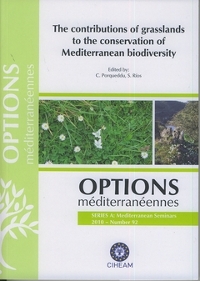| Article précédent | p. 241-245 | Article suivant |
A second generation of pasture legumes: An opportunity for improving the biodiversity in farming systems of Mediterranean basin ?
A screening of second generation pasture legumes was carried out through three experiments in different pedoclimatic regions of Sardinia (Italy). The main objective was to evaluate the adaptation and persistence of most new species and varieties selected in Australia. The response was quite different in relation to the site specific environmental characteristics. Some varieties shown difficulties of establishment and persistence and lower or similar forage productions compared to subterranean clovers, especially in the sites with higher edaphic and climatic limitations. For some accessions this was confirmed even with a satisfactory self-reseeding capability. The results give some indications about the potentiality of some second generation legumes for Sardinian farming systems and indicate that it may be possible to rely just on a restricted number of new varieties, accurately chosen site by site in regard of specific pedo-climatic conditions, if the main aim is the pasture improvement.
Une sélection des légumineuses de parcours de deuxième génération a été effectuée à travers trois expériences conduites dans différentes régions pédoclimatiques de la Sardaigne (Italie). L'objectif principal était d'évaluer l'adaptation et la persistance de la plupart des nouvelles espèces et variétés sélectionnées en Australie. La réponse était très différente par rapport aux caractéristiques environnementales spécifiques des sites. Quelques variétés ont montré des difficultés d'établissement et de persistance et une production de fourrage égale ou inférieure comparée aux trèfles souterrains, particulièrement dans les sites présentant des limitations édaphiques et climatiques élevées. Pour quelques accessions, ce fait a été confirmé même avec des capacités individuelles de réensemencement satisfaisantes. Les résultats donnent quelques indications concernant la potentialité de quelques légumineuses de deuxième génération pour les systèmes d'exploitation agricoles sardes et montrent qu'il n'est possible de compter que sur un nombre restreint de nouvelles variétés, soigneusement choisies site par site en fonction des conditions pédoclimatiques, si le but principal est l'amélioration des parcours.
- [ Afficher ]
- [ Télécharger ]
- [ Exporter la citation ]
Vous pouvez télécharger la citation au format :
- [ Imprimer ]
-
Mots-clés
AMELIORATION DES PATURAGES, ETABLISSEMENT DE LA PLANTE, FACTEUR LIE AU SITE, LEGUMINEUSE FOURRAGERE, REGION MEDITERRANEENNECiter cet article
Porqueddu C., Franca A., Sulas L. A second generation of pasture legumes: An opportunity for improving the biodiversity in farming systems of Mediterranean basin ?. In : Porqueddu C. (ed.), Ríos S. (ed.). The contributions of grasslands to the conservation of Mediterranean biodiversity. Zaragoza : CIHEAM / CIBIO / FAO / SEEP, 2010. p. 241-245. (Options Méditerranéennes : Série A. Séminaires Méditerranéens; n. 92). 13. Meeting of the Sub-Network on Mediterranean Forage Resources of the FAO-CIHEAM International Network for the Research and Development of Pasture and Forage Crops, 2010/04/07-10, Alicante (Spain). http://om.ciheam.org/om/pdf/a92/00801249.pdf



